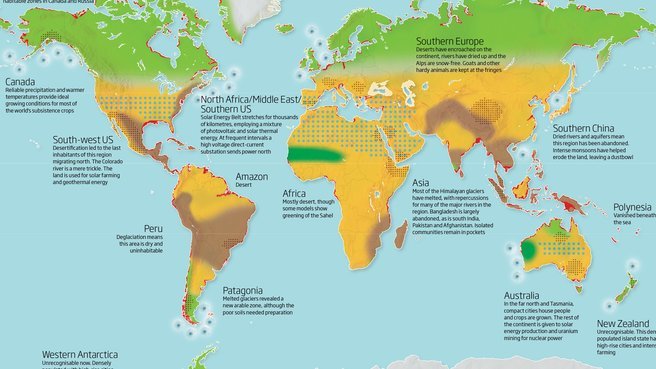If you believe in global warming or not, what I find interesting is contemplating what our world would look like IF we do indeed warm to a point where we have never seen before...

If we were +4 degrees Celsius, here is what the world would look like, and spoiler alert, it’s not ALL doom and gloom. We would survive and learn to adjust to a new world just as we always have.
Here are some interesting theories written by Frank Jacobs on Bigthink.com
The bad news-
- Micronesia is gone – sunk beneath the waves.
- Pakistan and South India have been abandoned.
- Europe is slowly turning into a desert
- Say goodbye to the Eastern Seaboard of the U.S., to Mexico and Central America, to the middle third of South America under water
- In Africa, Mozambique and Madagascar are gone
- Asia loses much of the Indian subcontinent, including all of Pakistan
- Indochina is abandoned, as is most of Indonesia
- The Colorado river is a mere trickle
- Peru is dry and uninhabitable
- Bangladesh is largely abandoned, as is South India
- Uninhabitable desert- most of the U.S. and the rest of South America, almost the entirety of Africa and the southern halves of Europe and Asia
- The Alps are now snow-free
The good news-
- Western Antarctica is no longer icy and uninhabitable and millions of people will be able to thrive there
- Northern Canada, Scandinavia and Siberia produce bountiful harvests to feed the hundreds of millions of climate refugees who now call those regions home
- Reforestation happens in certain areas of the world, including the Sahel and Western Australia
- The regions abandoned to desertification are empty, but not useless: they will be used for solar farming and geothermal energy
- Giant wind farms off the coasts of South America, Alaska and in the North Sea will generate the remainder of the planet's energy needs
New Scientist originally posted the map above.
Let me know what you think!
I'm glad it's not all bad news. But models? That's a laugh. As a software engineer with a degree, summa cum laude, and 40+ years studying climate science, I'm quite familiar with the efficacy of climate models. And it's not good.
I prefer to look at paleoclimate history and gain a rough understanding for what climate will likely do from what it has done before.
The notion that so many places will become desert is nonsense! Deserts and droughts are the product of weather patterns plus the availability of water vapor for clouds and rain. In a warmer world, rain would become far more common. Not every location would enjoy the increased rain, but more places would get it. The opposite is true with global cooling. In fact, during the last glacial period of the current Ice Age, the cooler oceans evaporated such a smaller degree of water that deserts were far more common, including the polar deserts which covered much of North America and northern Europe. We know this because civilization was virtually impossible to start without the agriculture and its required abundance of rain.
If you look at the climate history for Earth over the last 4.5 Billion years, you'll see that a vast majority of that history was spent far, far warmer than today—and life thrived! The tropics were still filled with life, even with +10C of warmer climate. And the polar regions were lush gardens. Deserts were smaller, but with a deeper dryness.
Here's one of my more recent topics on global warming.
Thank you for sharing your insight and expertise! Good to know that this guy was off base on some levels, and I never believe everything I read so thank you for your comment and video. I think politicians (on both sides) stretch the truth today regarding global warming so it is nice to get differing opinions and facts on the topic.
Hi! I am a robot. I just upvoted you! I found similar content that readers might be interested in:
http://bigthink.com/strange-maps/what-the-world-will-look-like-4degc-warmer
Thank you, I cited my source!
amazing
Thank you!
It's an important graphic to contemplate, because if you look at the map, the yellow and brown areas represent uninhabitable zones. Most of the world's 7.5 billion people live in those areas. That means the global population will have to endure resources scarcity, crop failure and food shortages, mass migration, and likely an accompanying escalation of violence, if this scenario comes to pass.
that is true! It is pretty bleak